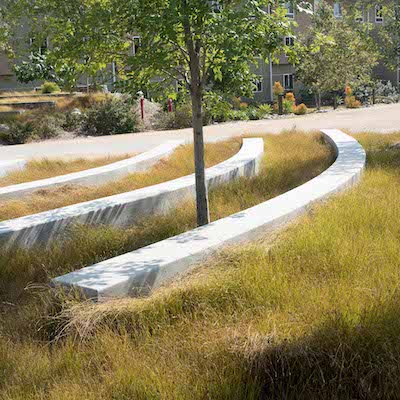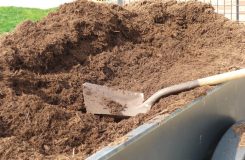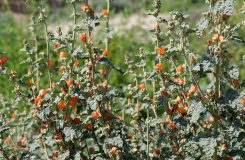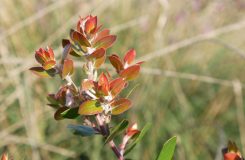Turf Alternatives
It’s waterwise to lose the lawn
Turf alternatives create lush spots in waterwise gardens while using a fraction of the water. Choose from our tested alternatives—a yarrow, a sedge, and a grass—to find the best option for your garden.
Woody groundcovers and shrubs are great alternatives to turf as well, but this page focuses on lower, softer options that can tolerate being walked on.
These turf alternatives require one-third to one-half the water of a traditional well-watered lawn
Create grassy spaces
Grassy spaces can provide a spot for picnicking, relaxing, and putting your feet in the grass. Dogs and casual foot traffic are welcome. Playtime is handled well, but no turf alternative can handle heavy use such as regular soccer practice as well as traditional turf options can. If your area will be heavily used on a regular basis, you may be best off with either a decomposed granite (DG) patio or a slightly lower-water traditional turf grass, such as St. Augustine or Bermuda, depending on how the area will be used.
See the Meadow Gardening page for information on how to integrate these options into a natural-looking meadowy landscape, or how to grow a single-species block of grass for a more conventional look.
Our favorite turf alternatives
All of our recommended turf alternatives are on display in separate plots in our Demonstration Garden.

Clustered field sedge
This tough grass-like plant thrives in full sun and shade, and provides a lush look with a lower water demand. It spreads aggressively by its root to form a dense meadowy area, so it may invade adjacent landscape areas without some maintenance or a root barrier. Long considered a medium-water plant in our area, clustered field sedge has been performing very well in a plot closer to a low-water plant receiving a deep watering once per week.

UC Verde buffalo grass
The best true "turf type" alternative of these three for foot traffic, mowing, and playing on, the UC Verde cultivar has been developed to stay lower and greener than the normal buffalo grass species. Because it looks similar to Bermuda grass, it’s extremely important to not only carefully and patiently kill all existing lawn, but also to keep an eye out for the slightly broader-leaved Bermuda grass to try to regrow into new buffalo grass plantings.

Yarrow
A ferny-leaved herbaceous California native plant, yarrow spreads from the roots and forms a dense patch that can take some occasional foot traffic. Its beautiful white blooms in spring, early summer, and fall attract butterflies, ladybugs, and many beneficial insects that also eat pest insects in the garden. Yarrow requires the most water out of the three examples here, but only a fraction of the water needed by a well-watered lawn. Smaller plantings of it can be mixed in among other areas of the garden.
Plant efficiently
Place 4-inch plants (or smaller plugs) 18 inches apart in thoroughly cleaned and prepared areas. This density is cost effective and fills in quickly. If elsewhere you research planting a lawn substitute, you’ll most likely find recommendations for much closer spacing. And though these species can all be planted closer, and will grow together faster, plant costs will also be much more expensive for the space. When installing our turf alternative plots in the Demonstration Garden, we tested multiple spacings and found an 18-inch spacing to be the best value while still growing in relatively quickly.

Part of why these options require less frequent mowing than traditional turf grasses is that they grow slower. This is useful long-term, but it means they are less able to compete with weeds when initially growing in. Success with turf alternatives highly depends on completely eliminating weeds and old grass regrowth prior to planting. This may mean waiting some time after the area is cleared before planting, setting up the irrigation, then beginning a “grow-kill” cycle, irrigating to stimulate weed seeds to germinate and any former turf grass to grow back, removing them, then continuing to the process until nothing comes back up. This can be a lot of work, and is part of the reason we generally do not recommend that an entire lawn be replaced by any turf alternative. Instead, use these options for smaller spaces and other plants for the rest of the landscape area.

If you’re looking to keep your landscape simple, low, and vegetated, but also want it to require low water and maintenance, we recommend lower-growing ground covers, such as a mix of Pigeon Point coyote brush, Canyon Gray sagebrush, and Theodore Payne buckwheat, with only a smaller functional area of one of our featured turf alternatives on a separate irrigation zone that can receive more water on a different schedule than the other areas.
Control Root Spread
All of our favorite turf alternatives spread from the roots. Install a root barrier or trim the plants to prevent unwanted growth into adjacent areas.
Trim occasionally
Cut back only once or twice a year for a more natural meadowy look, or more often to make it look more like a traditional lawn.

















